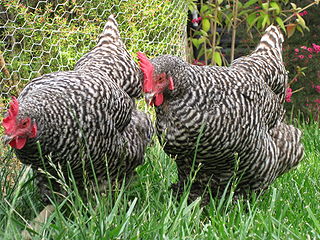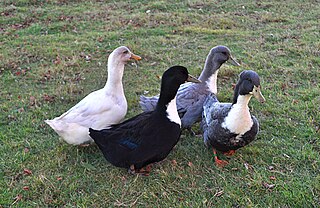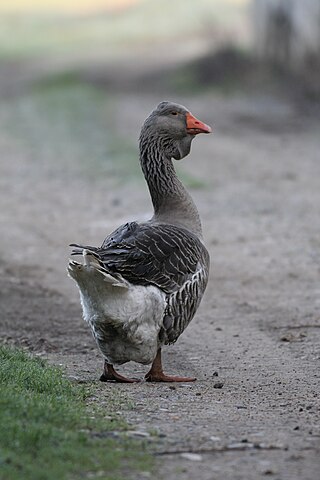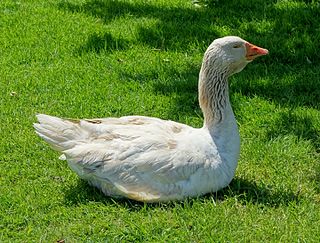
Poultry are domesticated birds kept by humans for the purpose of harvesting animal products such as meat, eggs or feathers. The practice of raising poultry is known as poultry farming. These birds are most typically members of the superorder Galloanserae (fowl), especially the order Galliformes. The term also includes waterfowls of the family Anatidae but does not include wild birds hunted for food known as game or quarry.

The Chinese is an international breed of domestic goose, known by this name in Europe and in North America. Unlike the majority of goose breeds, it belongs to the knob geese, which derive from Anser cygnoides and are characterised by a prominent basal knob on the upper side of the bill. It originates in China, where there are more than twenty different breeds of knob goose.

The Australorp is an Australian breed of dual-purpose utility chicken. It derives from the British Black Orpington, and was selectively bred for egg-laying performance; some hens lay more than 300 eggs per year. It achieved world-wide popularity in the 1920s after the breed broke numerous world records for number of eggs laid and has been a popular breed in the western world since. It is one of eight poultry breeds created in Australia and recognised by the Australian Poultry Standards. The original plumage colour is black, which is the only colour recognised in the United States of America, but blue and white are also recognised in Australia and the Poultry Club South Africa recognises buff, splash, wheaten laced and golden in addition.

A domestic goose is a goose that humans have domesticated and kept for their meat, eggs, or down feathers, or as companion animals. Domestic geese have been derived through selective breeding from the wild greylag goose and swan goose.

The Plymouth Rock is an American breed of domestic chicken. It was first seen in Massachusetts in the nineteenth century and for much of the early twentieth century was the most widely kept chicken breed in the United States. It is a dual-purpose bird, raised both for its meat and for its brown eggs. It is resistant to cold, easy to manage, and a good sitter.

The Ancona is a breed of chicken which originated in the Marches, region of Italy, but which was bred to its present type mainly in the United Kingdom in the nineteenth century. It is named after the city of Ancona, capital of the Marche. It is popular in Britain and the United States, but uncommon in Italy; an initiative to re-establish it in its native area and preserve its biodiversity was launched in 2000. There are also Ancona bantams.

The Swedish Blue or Blue Swedish is a Swedish breed of domestic duck. It originated in the former dominion of Swedish Pomerania – now in north-west Poland and north-east Germany – and is documented there from 1835. It is closely similar to the Pomeranian Duck from the same general area, differing mainly in its white primary feathers.

The Toulouse is a French breed of large domestic goose, originally from the area of Toulouse in south-western France. Two types are recognised: a heavy industrial type with dewlaps, the French: Oie de Toulouse à bavette; and a slightly lighter agricultural type without dewlaps, the French: Oie de Toulouse sans bavette. Both types are large, with weights of up to 9 kg. Birds bred in the United Kingdom and United States exclusively for showing may be still larger, and have a somewhat different conformation.

The New Hampshire Red or New Hampshire is an American breed of chicken. It was developed in the early twentieth century in the state of New Hampshire by selective breeding of Rhode Island Red stock; no other breed was involved. It is fast-growing, early-maturing, quick-feathering, and yields a meaty carcass. Mature birds are a light or medium red in color; they may fade in sunlight.

The Orpington or Buff Orpington Duck is a breed of domestic duck. It is a dual-purpose breed used for meat and egg production. It is capable of laying up to 220 eggs a year. Originally created by William Cook of Orpington, Kent, England, from the selection of mis-marked Blue Orpington Ducks; Cook was also the developer of the Orpington chicken. The breeds used in the development of the breed included Cayuga, Indian Runner, commercial Aylesbury and Rouen. It is proposed that Cook's intentions for the breed were to capitalize on the growing demand for the buff colour pattern. The Buff Orpington Duck was introduced to the public at the Dairy Show, the Agricultural Hall (q.v.), Islington, London in October 1897. It is considered a threatened breed by the ALBC. This breed was admitted to the British Poultry Standard in 1910 and the American Poultry Associations Standard of Perfection as the 'Buff Duck' in the Medium class in 1914. The Orpington duck is available in three colour varieties: Buff, Blond and Brown. The Buff Orpington is an unstable colour due to a blue dilution gene which means that from the offspring, all three colour variations will appear.

The American Buff is an American breed of domestic goose. It was accepted by the American Poultry Association in 1947. It is named for its single plumage variety, which is a pale buff or apricot-fawn in color.

The African or African Goose is a breed of domestic goose. It is one of two domestic breeds that derive from the wild species Anser cygnoides, the other being the Chinese; all other domestic geese derive from Anser anser. Despite the name, it is not from Africa but is of Chinese origin, found in Teochew and Swatow of South China. It is a large bird, among the heaviest of all goose breeds.

Pilgrim geese are a breed of domestic goose. They are considered to be a relatively quiet, lightweight and medium-sized breed. The pilgrim goose is a rare and critically endangered species according to the American Livestock Breeds Conservancy (ALBC) and was officially entered into the American Poultry Association's Standard of Perfection in 1939. Generally, they can live for 15 to 25 years. In most breeds of geese, males and females are indistinguishable from one another; however, the pilgrim goose is well known for its auto-sexing trait. Males are characterised by white feathers while the females have grey. This sexual dimorphism makes pilgrim geese desirable for breeding as the sexes are easily determined. Their commercial use is primarily limited to the United States where they are bred for eggs and meat. They are known to grow relatively fast and are easy to handle.
The Nankin Bantam or Nankin is a British bantam breed of chicken. It is a true bantam, a naturally small breed with no large counterpart from which it was miniaturised. It is of South-east Asian origin, and is among the oldest bantam breeds. It is a yellowish buff colour, and the name is thought to derive from the colour of nankeen cotton from China.

The Pomeranian goose, also known as the Rügener goose, is a breed of domestic goose.
The Shetland goose is a breed of domestic geese that originates in the Shetland Islands of Scotland. Like the other breeds of livestock native to the islands, the Shetland goose is small in stature, generally weighing between 12 and 14 pounds. They are very hardy and exceptionally good foragers, and are able to largely sustain themselves through grazing.

The Cotton Patch is a breed of domestic goose originating in the Southern United States. It is so named because it traditionally was used to weed fields of cotton, corn, and other crops.
The Elizabeth duck is a breed of domestic duck, originating in Australia. They were developed as a small, fast growing meat breed in 1972 by Lance Ruting in Merrylands, New South Wales and named after his wife, Ann Elizabeth Ruting. They are presently bred in Australia and New Zealand, but are not widely available and classified as endangered by the Rare Breeds Trust of Australia.

Danish landrace goose, or Danish goose, is a landrace variety of goose native to Denmark.

















